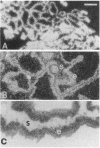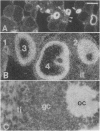Abstract
We have cloned a novel member of the nuclear receptor superfamily. The cDNA of clone 29 was isolated from a rat prostate cDNA library and it encodes a protein of 485 amino acid residues with a calculated molecular weight of 54.2 kDa. Clone 29 protein is unique in that it is highly homologous to the rat estrogen receptor (ER) protein, particularly in the DNA-binding domain (95%) and in the C-terminal ligand-binding domain (55%). Expression of clone 29 in rat tissues was investigated by in situ hybridization and prominent expression was found in prostate and ovary. In the prostate clone 29 is expressed in the epithelial cells of the secretory alveoli, whereas in the ovary the granuloma cells in primary, secondary, and mature follicles showed expression of clone 29. Saturation ligand-binding analysis of in vitro synthesized clone 29 protein revealed a single binding component for 17beta-estradiol (E2) with high affinity (Kd= 0.6 nM). In ligand-competition experiments the binding affinity decreased in the order E2 > diethylstilbestrol > estriol > estrone > 5alpha-androstane-3beta,17beta-diol >> testosterone = progesterone = corticosterone = 5alpha-androstane-3alpha,17beta-diol. In cotransfection experiments of Chinese hamster ovary cells with a clone 29 expression vector and an estrogen-regulated reporter gene, maximal stimulation (about 3-fold) of reporter gene activity was found during incubation with 10 nM of E2. Neither progesterone, testosterone, dexamethasone, thyroid hormone, all-trans-retinoic acid, nor 5alpha-androstane-3alpha,I7beta-diol could stimulate reporter gene activity, whereas estrone and 5alpha-androstane-3beta,17beta-diol did. We conclude that clone 29 cDNA encodes a novel rat ER, which we suggest be named rat ERbeta to distinguish it from the previously cloned ER (ERalpha) from rat uterus.
Full text
PDF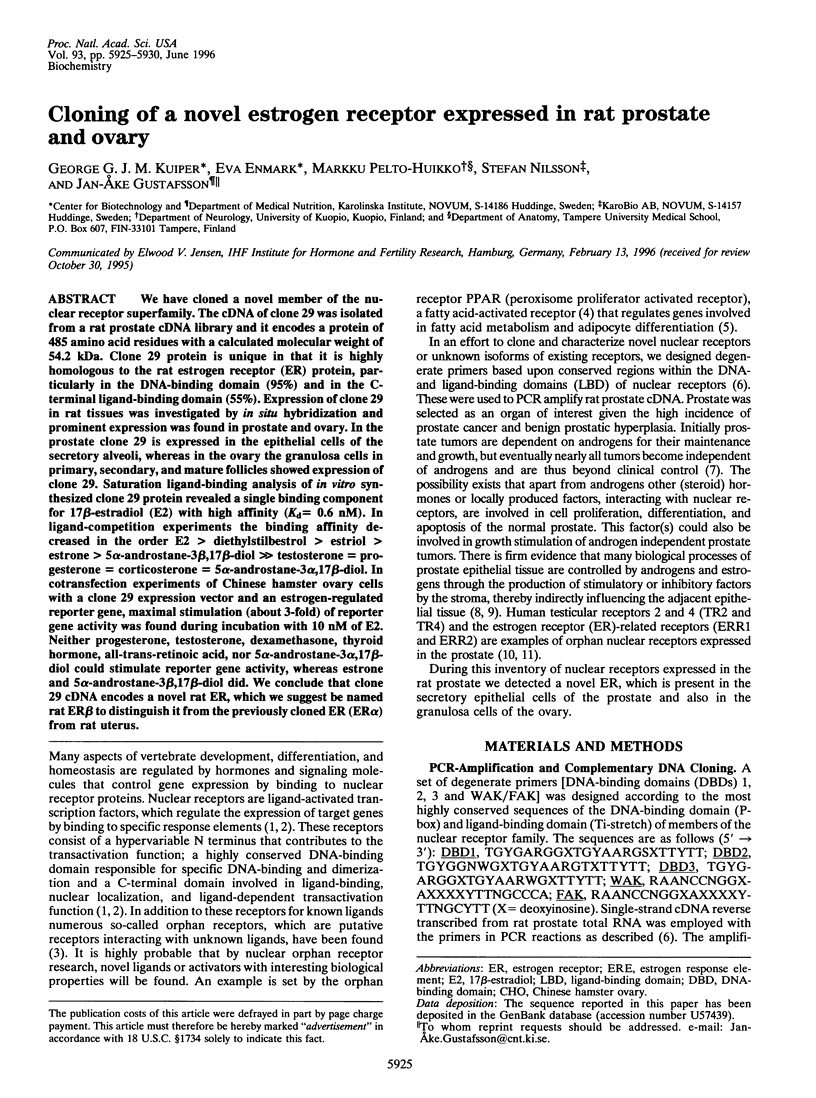
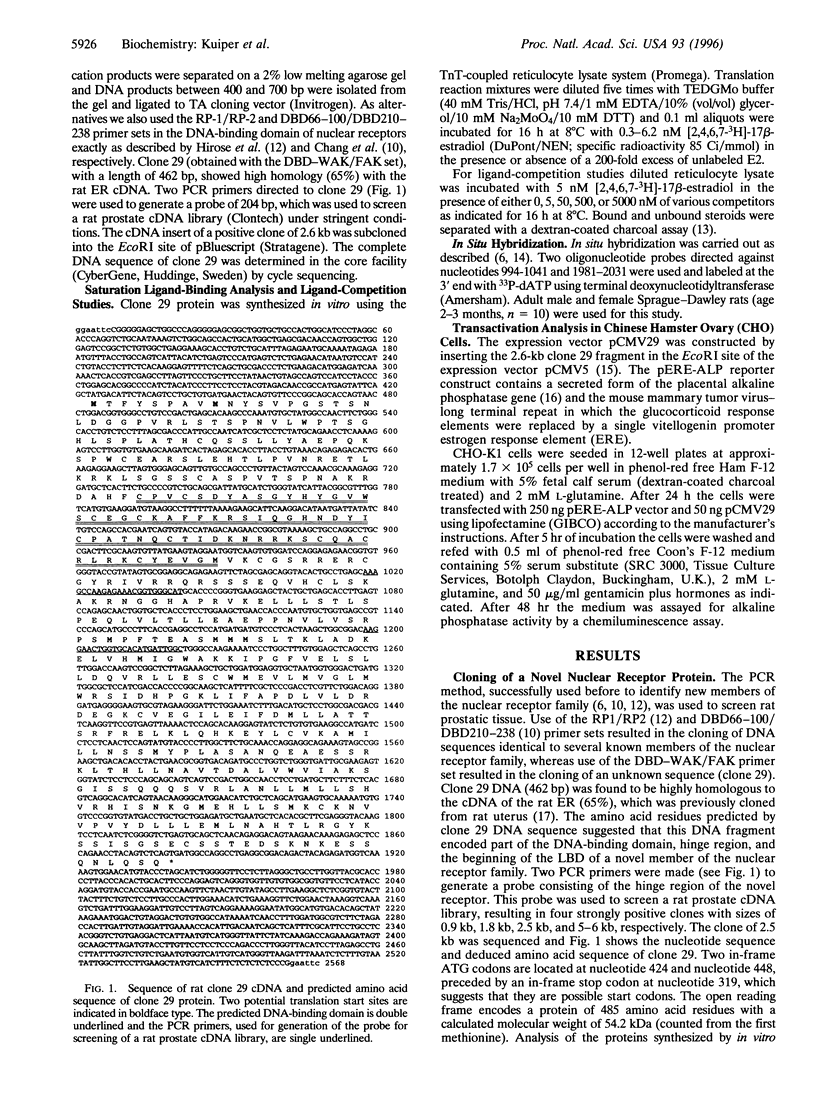
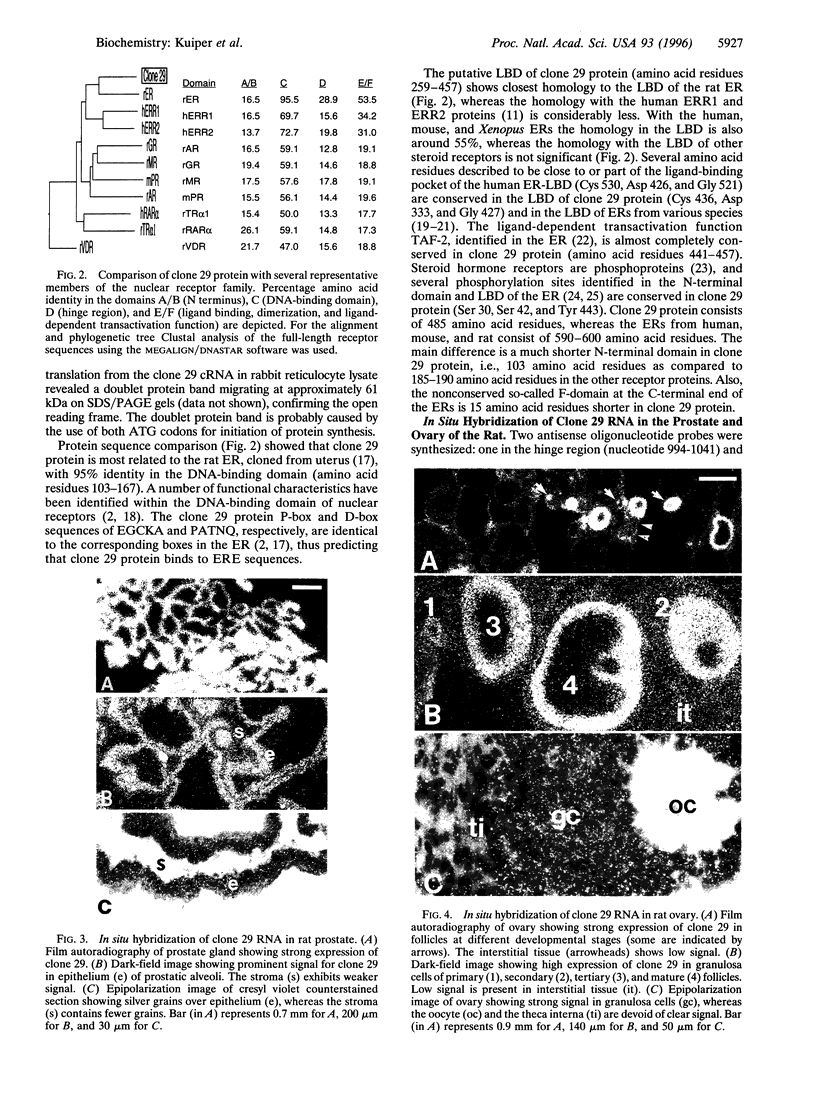
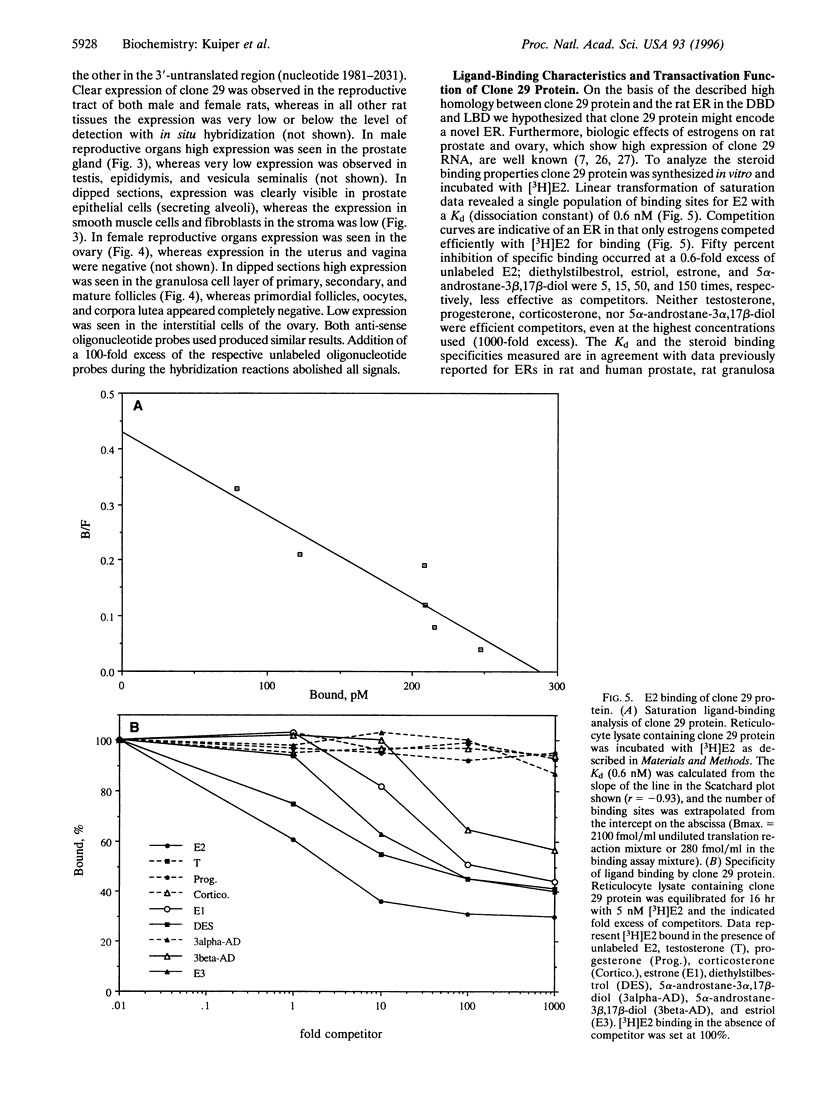
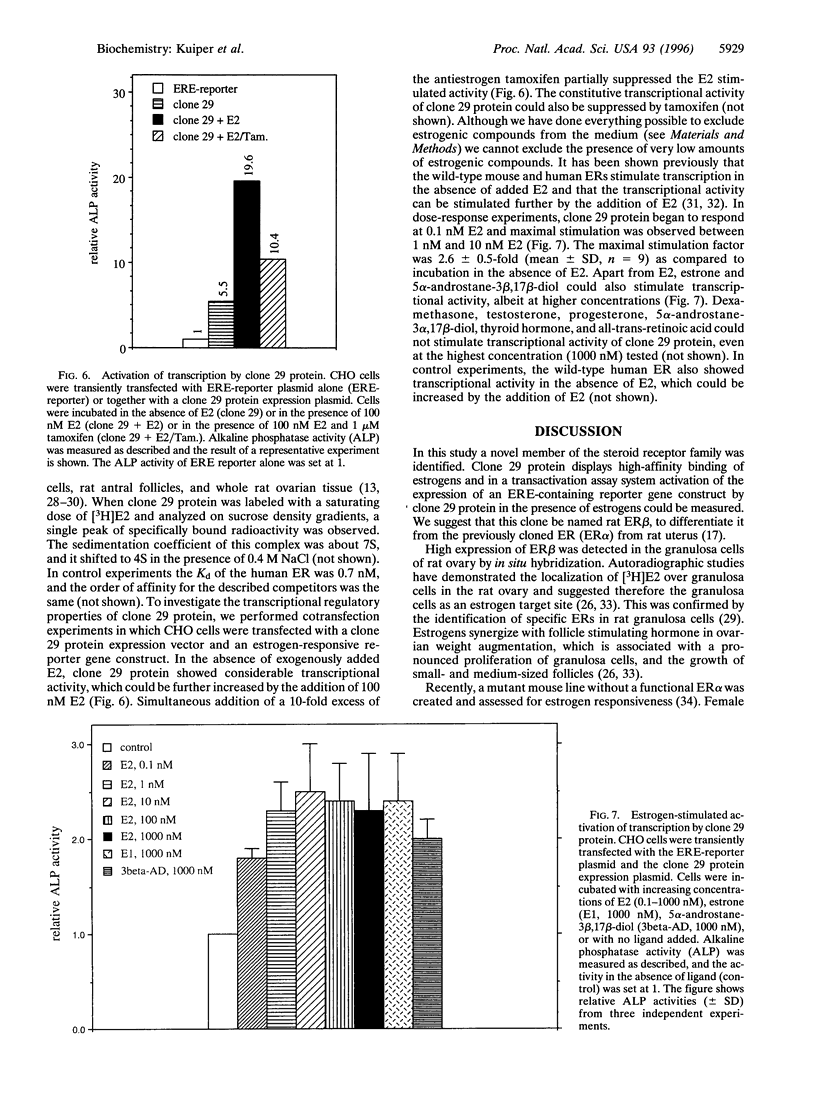
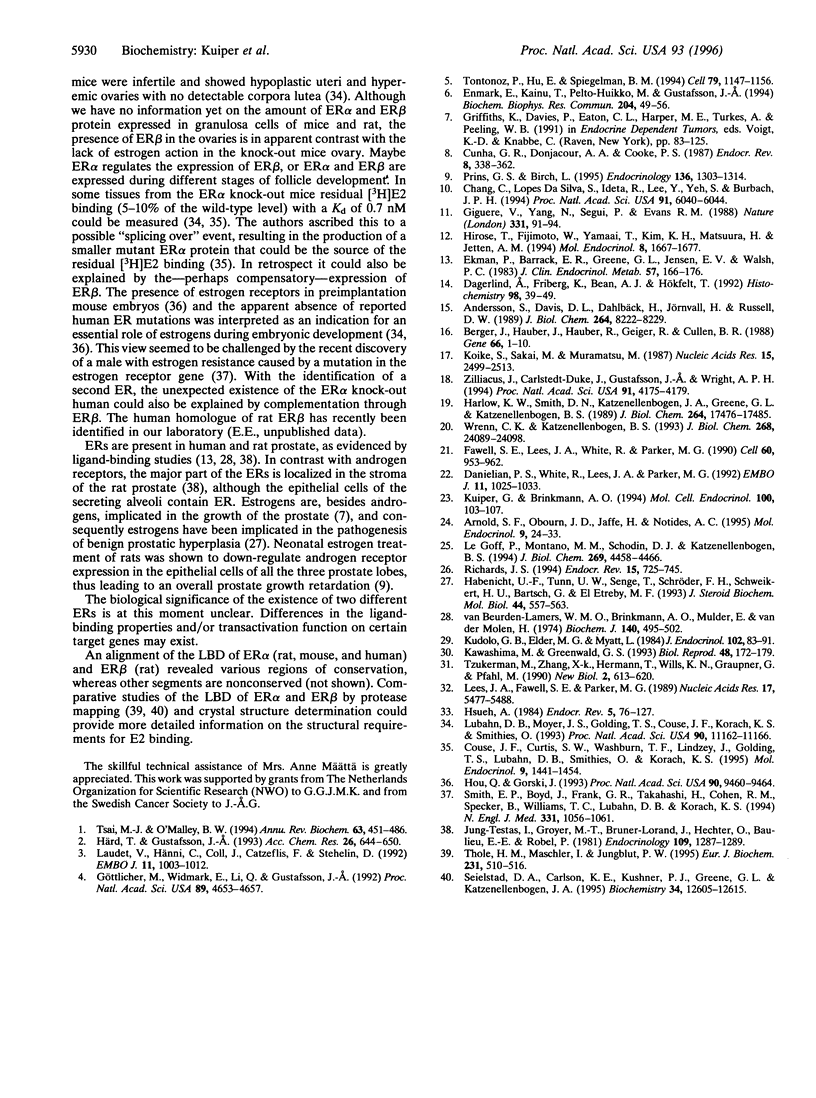
Images in this article
Selected References
These references are in PubMed. This may not be the complete list of references from this article.
- Andersson S., Davis D. L., Dahlbäck H., Jörnvall H., Russell D. W. Cloning, structure, and expression of the mitochondrial cytochrome P-450 sterol 26-hydroxylase, a bile acid biosynthetic enzyme. J Biol Chem. 1989 May 15;264(14):8222–8229. [PubMed] [Google Scholar]
- Arnold S. F., Obourn J. D., Jaffe H., Notides A. C. Phosphorylation of the human estrogen receptor on tyrosine 537 in vivo and by src family tyrosine kinases in vitro. Mol Endocrinol. 1995 Jan;9(1):24–33. doi: 10.1210/mend.9.1.7539106. [DOI] [PubMed] [Google Scholar]
- Berger J., Hauber J., Hauber R., Geiger R., Cullen B. R. Secreted placental alkaline phosphatase: a powerful new quantitative indicator of gene expression in eukaryotic cells. Gene. 1988 Jun 15;66(1):1–10. doi: 10.1016/0378-1119(88)90219-3. [DOI] [PubMed] [Google Scholar]
- Chang C., Da Silva S. L., Ideta R., Lee Y., Yeh S., Burbach J. P. Human and rat TR4 orphan receptors specify a subclass of the steroid receptor superfamily. Proc Natl Acad Sci U S A. 1994 Jun 21;91(13):6040–6044. doi: 10.1073/pnas.91.13.6040. [DOI] [PMC free article] [PubMed] [Google Scholar]
- Couse J. F., Curtis S. W., Washburn T. F., Lindzey J., Golding T. S., Lubahn D. B., Smithies O., Korach K. S. Analysis of transcription and estrogen insensitivity in the female mouse after targeted disruption of the estrogen receptor gene. Mol Endocrinol. 1995 Nov;9(11):1441–1454. doi: 10.1210/mend.9.11.8584021. [DOI] [PubMed] [Google Scholar]
- Cunha G. R., Donjacour A. A., Cooke P. S., Mee S., Bigsby R. M., Higgins S. J., Sugimura Y. The endocrinology and developmental biology of the prostate. Endocr Rev. 1987 Aug;8(3):338–362. doi: 10.1210/edrv-8-3-338. [DOI] [PubMed] [Google Scholar]
- Dagerlind A., Friberg K., Bean A. J., Hökfelt T. Sensitive mRNA detection using unfixed tissue: combined radioactive and non-radioactive in situ hybridization histochemistry. Histochemistry. 1992 Aug;98(1):39–49. doi: 10.1007/BF00716936. [DOI] [PubMed] [Google Scholar]
- Danielian P. S., White R., Lees J. A., Parker M. G. Identification of a conserved region required for hormone dependent transcriptional activation by steroid hormone receptors. EMBO J. 1992 Mar;11(3):1025–1033. doi: 10.1002/j.1460-2075.1992.tb05141.x. [DOI] [PMC free article] [PubMed] [Google Scholar]
- Ekman P., Barrack E. R., Greene G. L., Jensen E. V., Walsh P. C. Estrogen receptors in human prostate: evidence for multiple binding sites. J Clin Endocrinol Metab. 1983 Jul;57(1):166–176. doi: 10.1210/jcem-57-1-166. [DOI] [PubMed] [Google Scholar]
- Enmark E., Kainu T., Pelto-Huikko M., Gustafsson J. A. Identification of a novel member of the nuclear receptor superfamily which is closely related to Rev-ErbA. Biochem Biophys Res Commun. 1994 Oct 14;204(1):49–56. doi: 10.1006/bbrc.1994.2424. [DOI] [PubMed] [Google Scholar]
- Fawell S. E., Lees J. A., White R., Parker M. G. Characterization and colocalization of steroid binding and dimerization activities in the mouse estrogen receptor. Cell. 1990 Mar 23;60(6):953–962. doi: 10.1016/0092-8674(90)90343-d. [DOI] [PubMed] [Google Scholar]
- Giguère V., Yang N., Segui P., Evans R. M. Identification of a new class of steroid hormone receptors. Nature. 1988 Jan 7;331(6151):91–94. doi: 10.1038/331091a0. [DOI] [PubMed] [Google Scholar]
- Göttlicher M., Widmark E., Li Q., Gustafsson J. A. Fatty acids activate a chimera of the clofibric acid-activated receptor and the glucocorticoid receptor. Proc Natl Acad Sci U S A. 1992 May 15;89(10):4653–4657. doi: 10.1073/pnas.89.10.4653. [DOI] [PMC free article] [PubMed] [Google Scholar]
- Habenicht U. F., Tunn U. W., Senge T., Schröder F. H., Schweikert H. U., Bartsch G., el Etreby M. F. Management of benign prostatic hyperplasia with particular emphasis on aromatase inhibitors. J Steroid Biochem Mol Biol. 1993 Mar;44(4-6):557–563. doi: 10.1016/0960-0760(93)90259-y. [DOI] [PubMed] [Google Scholar]
- Harlow K. W., Smith D. N., Katzenellenbogen J. A., Greene G. L., Katzenellenbogen B. S. Identification of cysteine 530 as the covalent attachment site of an affinity-labeling estrogen (ketononestrol aziridine) and antiestrogen (tamoxifen aziridine) in the human estrogen receptor. J Biol Chem. 1989 Oct 15;264(29):17476–17485. [PubMed] [Google Scholar]
- Hirose T., Fujimoto W., Tamaai T., Kim K. H., Matsuura H., Jetten A. M. TAK1: molecular cloning and characterization of a new member of the nuclear receptor superfamily. Mol Endocrinol. 1994 Dec;8(12):1667–1680. doi: 10.1210/mend.8.12.7708055. [DOI] [PubMed] [Google Scholar]
- Hou Q., Gorski J. Estrogen receptor and progesterone receptor genes are expressed differentially in mouse embryos during preimplantation development. Proc Natl Acad Sci U S A. 1993 Oct 15;90(20):9460–9464. doi: 10.1073/pnas.90.20.9460. [DOI] [PMC free article] [PubMed] [Google Scholar]
- Hsueh A. J., Adashi E. Y., Jones P. B., Welsh T. H., Jr Hormonal regulation of the differentiation of cultured ovarian granulosa cells. Endocr Rev. 1984 Winter;5(1):76–127. doi: 10.1210/edrv-5-1-76. [DOI] [PubMed] [Google Scholar]
- Jung-Testas I., Groyer M. T., Bruner-Lorand J., Hechter O., Baulieu E. E., Robel P. Androgen and estrogen receptors in rat ventral prostate epithelium and stroma. Endocrinology. 1981 Oct;109(4):1287–1289. doi: 10.1210/endo-109-4-1287. [DOI] [PubMed] [Google Scholar]
- Kawashima M., Greenwald G. S. Comparison of follicular estrogen receptors in rat, hamster, and pig. Biol Reprod. 1993 Jan;48(1):172–179. doi: 10.1095/biolreprod48.1.172. [DOI] [PubMed] [Google Scholar]
- Koike S., Sakai M., Muramatsu M. Molecular cloning and characterization of rat estrogen receptor cDNA. Nucleic Acids Res. 1987 Mar 25;15(6):2499–2513. doi: 10.1093/nar/15.6.2499. [DOI] [PMC free article] [PubMed] [Google Scholar]
- Kudolo G. B., Elder M. G., Myatt L. A novel oestrogen-binding species in rat granulosa cells. J Endocrinol. 1984 Jul;102(1):83–91. doi: 10.1677/joe.0.1020083. [DOI] [PubMed] [Google Scholar]
- Kuiper G. G., Brinkmann A. O. Steroid hormone receptor phosphorylation: is there a physiological role? Mol Cell Endocrinol. 1994 Apr;100(1-2):103–107. doi: 10.1016/0303-7207(94)90287-9. [DOI] [PubMed] [Google Scholar]
- Laudet V., Hänni C., Coll J., Catzeflis F., Stéhelin D. Evolution of the nuclear receptor gene superfamily. EMBO J. 1992 Mar;11(3):1003–1013. doi: 10.1002/j.1460-2075.1992.tb05139.x. [DOI] [PMC free article] [PubMed] [Google Scholar]
- Le Goff P., Montano M. M., Schodin D. J., Katzenellenbogen B. S. Phosphorylation of the human estrogen receptor. Identification of hormone-regulated sites and examination of their influence on transcriptional activity. J Biol Chem. 1994 Feb 11;269(6):4458–4466. [PubMed] [Google Scholar]
- Lees J. A., Fawell S. E., Parker M. G. Identification of two transactivation domains in the mouse oestrogen receptor. Nucleic Acids Res. 1989 Jul 25;17(14):5477–5488. doi: 10.1093/nar/17.14.5477. [DOI] [PMC free article] [PubMed] [Google Scholar]
- Lubahn D. B., Moyer J. S., Golding T. S., Couse J. F., Korach K. S., Smithies O. Alteration of reproductive function but not prenatal sexual development after insertional disruption of the mouse estrogen receptor gene. Proc Natl Acad Sci U S A. 1993 Dec 1;90(23):11162–11166. doi: 10.1073/pnas.90.23.11162. [DOI] [PMC free article] [PubMed] [Google Scholar]
- Prins G. S., Birch L. The developmental pattern of androgen receptor expression in rat prostate lobes is altered after neonatal exposure to estrogen. Endocrinology. 1995 Mar;136(3):1303–1314. doi: 10.1210/endo.136.3.7867585. [DOI] [PubMed] [Google Scholar]
- Richards J. S. Hormonal control of gene expression in the ovary. Endocr Rev. 1994 Dec;15(6):725–751. doi: 10.1210/edrv-15-6-725. [DOI] [PubMed] [Google Scholar]
- Seielstad D. A., Carlson K. E., Kushner P. J., Greene G. L., Katzenellenbogen J. A. Analysis of the structural core of the human estrogen receptor ligand binding domain by selective proteolysis/mass spectrometric analysis. Biochemistry. 1995 Oct 3;34(39):12605–12615. doi: 10.1021/bi00039a016. [DOI] [PubMed] [Google Scholar]
- Smith E. P., Boyd J., Frank G. R., Takahashi H., Cohen R. M., Specker B., Williams T. C., Lubahn D. B., Korach K. S. Estrogen resistance caused by a mutation in the estrogen-receptor gene in a man. N Engl J Med. 1994 Oct 20;331(16):1056–1061. doi: 10.1056/NEJM199410203311604. [DOI] [PubMed] [Google Scholar]
- Thole H. H., Maschler I., Jungblut P. W. Surface mapping of the ligand-filled C-terminal half of the porcine estradiol receptor by restricted proteolysis. Eur J Biochem. 1995 Jul 15;231(2):510–516. doi: 10.1111/j.1432-1033.1995.tb20726.x. [DOI] [PubMed] [Google Scholar]
- Tontonoz P., Hu E., Spiegelman B. M. Stimulation of adipogenesis in fibroblasts by PPAR gamma 2, a lipid-activated transcription factor. Cell. 1994 Dec 30;79(7):1147–1156. doi: 10.1016/0092-8674(94)90006-x. [DOI] [PubMed] [Google Scholar]
- Tsai M. J., O'Malley B. W. Molecular mechanisms of action of steroid/thyroid receptor superfamily members. Annu Rev Biochem. 1994;63:451–486. doi: 10.1146/annurev.bi.63.070194.002315. [DOI] [PubMed] [Google Scholar]
- Tzukerman M., Zhang X. K., Hermann T., Wills K. N., Graupner G., Pfahl M. The human estrogen receptor has transcriptional activator and repressor functions in the absence of ligand. New Biol. 1990 Jul;2(7):613–620. [PubMed] [Google Scholar]
- Wrenn C. K., Katzenellenbogen B. S. Structure-function analysis of the hormone binding domain of the human estrogen receptor by region-specific mutagenesis and phenotypic screening in yeast. J Biol Chem. 1993 Nov 15;268(32):24089–24098. [PubMed] [Google Scholar]
- Zilliacus J., Carlstedt-Duke J., Gustafsson J. A., Wright A. P. Evolution of distinct DNA-binding specificities within the nuclear receptor family of transcription factors. Proc Natl Acad Sci U S A. 1994 May 10;91(10):4175–4179. doi: 10.1073/pnas.91.10.4175. [DOI] [PMC free article] [PubMed] [Google Scholar]
- van Beurden-Lamers W. M., Brinkmann A. O., Mulder E., van der Molen H. J. High-affinity binding of oestradiol-17beta by cytosols from testis interstitial tissue, pituitary, adrenal, liver and accessory sex glands of the male rat. Biochem J. 1974 Jun;140(3):495–502. doi: 10.1042/bj1400495. [DOI] [PMC free article] [PubMed] [Google Scholar]



